How to make Kimchi – a quick and easy recipe that only takes 30 minutes of hands-on time before mother nature takes over! Full of healthy, gut-healing probiotics, the benefits of eating kimchi are endless. This authentic kimchi recipe is vegan adaptable, gluten-free and can be made as spicy or as mild as you like! Includes a video.
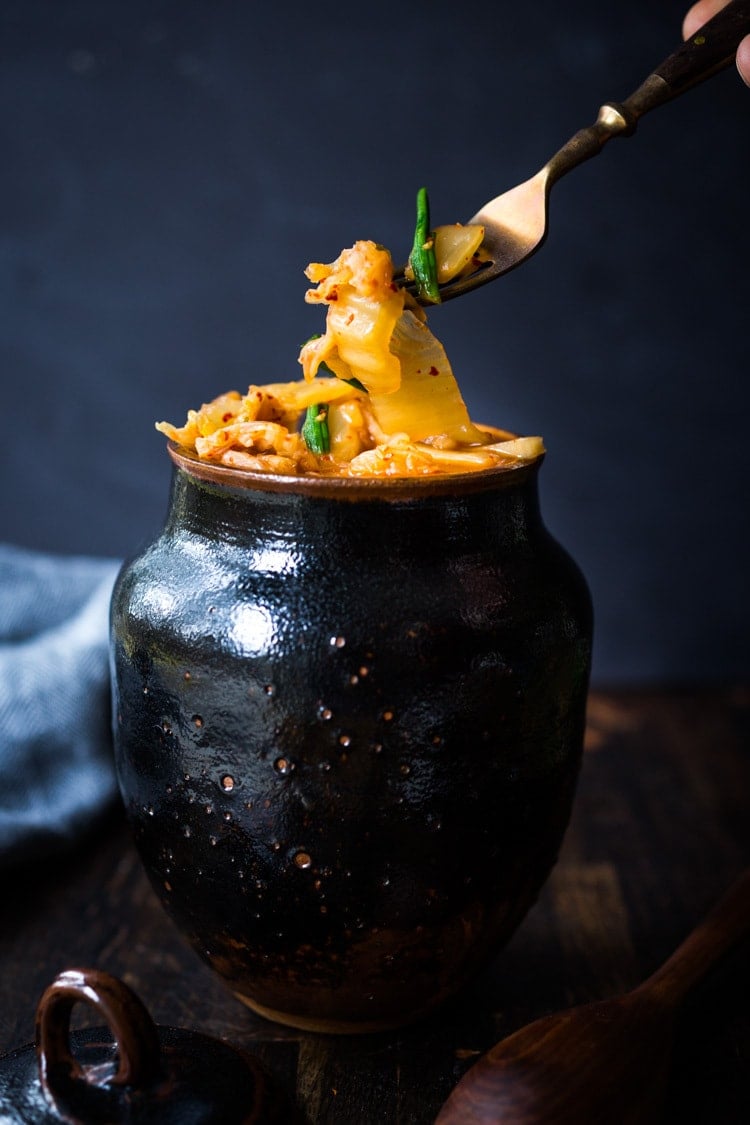 We are never in as much joy as when we are engaged in the well-being of others. ~ Adyashanti
We are never in as much joy as when we are engaged in the well-being of others. ~ Adyashanti
Many years ago now, we catered a Korean wedding. I remember meeting with the bride and groom and listening very carefully about the importance of the kimchi being served. It had to be “just right”.
Truth be told I was nervous, I had never made it back then, but the mother of the bride was kind enough to send me her personal kimchi recipe and thankfully I had time to practice it a few times before the big day.
In the end, they were happy. And wherever they are now, I hope they are still. I’ve never counted the number of weddings we’ve catered, but every so often a couple pops into my mind, most often when I’m cooking, and I can’t help but give them a little nod and wish them well.
HOW TO MAKE KIMCHI!| 60-second video
What is Kimchi?
Some of you may still be unfamiliar with kimchi even though it’s become highly popular in the last 15 years here in the west. It’s basically spicy, fermented cabbage, kind of like sauerkraut, but with Korean flavors – garlic, ginger & Korean chilies. Kimchi is like the heart and soul of Korean cooking. And it’s tasty with so many things!
But the best thing about Kimchi? Kimchi is alive! Full of living, healthy good bacteria, or probiotics, that boost immunity, energize the body, and aid digestion, it is believed to fight cancer, lower cholesterol and regulate blood sugar. Just google it and see for yourself.
Now if you are buying kimchi (which is totally fine!) just make sure it is in the refrigerated section of the grocery store (then you know it is alive) and check for preservatives, especially nitrates- stay away from those. It is usually fine if it is refrigerated!
What does Kimchi Taste like?
Kimchi tastes sour, tangy, salty, spicy, and pungent! It’s similar to sauerkraut in that it is fermented cabbage, but kimchi is packed with flavor, umami and a little (or a lot) of heat! The fermentation process is what gives kimchi its sour flavor.
Why eat Kimchi?
Because kimchi is naturally fermented, it is full of healthy bacteria, good for the gut and good for immunity. But besides being a healthy thing to incorporate into our diets, Kimchi adds so much flavor to things we are already making at home!
What you’ll need:
This easy kimchi recipe makes enough to fill a large two-quart jar (about 8 cups).
- One large Napa Cabbage.
- Ginger
- Garlic
- Scallions
- Fish sauce, shrimp paste or miso (vegan version)
- Korean Chili Flakes called Gochugaru (or Gochujang)
In this recipe, I use Korean Chili Flakes called “Gochugaru” vs. the Korean fermented Chili Paste called “Gochujang“. Feel free to use Gochujang if you please or if you have it on hand.
The reason I decided not to use the Gochujang, is Gochujang usually contains MSG and Nitrates, so I went a cleaner route today. Totally up to you.
You can find Gochugaru at most Asian Markets or order online. You can add other veggies to the mix like matchstick daikon radish or carrots.
Vegan Kimchi options:
- Fish sauce adds depth but you can leave this out- and use soy sauce, miso paste or vegan fish sauce.
- Use miso paste to add depth, flavor and also more probiotics- especially if going vegan.
- Gluten-free version, liquid aminos work well too.
Kimchi Variations:
- Like so many things, there are so many variations to kimchi, and people have their own personal preferences. I just wanted to provide you with a starting point, and I’m sure you will adapt to your own tastes!
- Some people add sugar, some don’t.
- Some add carrots, some don’t.
- And, to be clear this is not the exact recipe from the mother of the bride, but a little simplified. The ingredients are similar (except I believe she added dried shrimp) but I tried to make this as easy as possible.
- And guess what? It IS easy! And fun!
How to make Kimchi (in a nutshell)
****See the recipe for more detailed instructions.
- Save 1-2 outer leaves and place in a bag in the fridge (you will use these later).
- Cut the Napa cabbage into 1-inch cubes.
- Place napa cabbage in a bowl and toss with 1/4 cup sea salt.
- Fill the bowl with filtered water and stir, and soak cabbage for 6-8 hours.
- Place plate over the napa cabbage to keep it submerged.
- After 6- 8 hours, drain (making sure to save the brine) and rinse, pressing the liquid out.
Make the Kimchi Paste:
- As I stated earlier, I prefer to use Korean Chili Flakes called “Gochugaru” vs. the Korean fermented Chili Paste called “Gochujang“. Feel free to use Gochujang if you please. Totally up to you. Either way, you will make the paste below.
- Many people ask if they can use regular old chili flakes- yes, but they are much spicier!!! Gochugaru is fruitier and less spicy, so you can use more and get more flavor. You could try subbing dried Arbol Chilies if you absolutely can’t get the Korean Chili flakes – or even use fresh red chilies to make the paste.
- In a food processor, make a paste with garlic, ginger, shallot, Korean chili flakes (or Gochujang) and optional fish sauce (or miso) and sugar. If you want a mild version, use half the chili flakes. The fish sauce really adds a delicious complexity and depth, but you can, of course, keep it vegan.
- Peel and cut the daikon radish (or carrot) into match sticks, about 2-3 inches long. Cut the scallions.
- Cut the scallions into 1-2 inch pieces.
- Place the drained cabbage along with the daikon, scallions and chili paste into the bowl. Massage a bit with gloved hands.
- This is a very mild version shown below, so not very red, ( 2 tablespoons chili flakes).
- You can also add more chili flakes if you want it spicier – I normally add 4-6 tablespoons.
- Pack this tightly into a large two-quart jar (half-gallon, 64 oz) or large crock. (Or use two, quart-sized mason jars.)
- You want a good two inches of space at the top to catch the flavorful liquid that will release.
- I have had great success with this Fermentation Kit that has crystal weights that fit perfectly in a wide-mouth mason jar. It is so convenient for small batch ferments. This fermentation kit includes the jars which is a great option too!
- Pour a little of the brine into the jar, just to enough to cover the cabbage.
- Cover with the cabbage leaf you saved, and press down. The leaf will help keep the cabbage submerged. Add a fermentation weight to keep the cabbage submerged. Cover with a lid ( do not screw on tight) and place on a rimmed pan or bowl ( to collect any overflow) and set somewhere cool and dark like the basement for 3-5 days. A lower kitchen cabinet away from stove or appliances can also be a good cool spot.
What temperature to ferment Kimchi:
- The ideal temperature for fermenting kimchi 55-65 degrees. 65 F is perfect!
- The cooler it is, the slower it will take to ferment. The warmer, the faster.
- The longer you ferment the tangier and the softer the kimchi will get. I actually prefer slightly crunchy kimchi.
- Going too much over 70 degrees may actually have negative effects on the flavor.
How do you know if kimchi is fermenting?
- After 3 days. Tap the jar to see if any bubbles rise to the top- indicating that it is fermenting.
- Taste the kimchi for tanginess.
- Continue to ferment for 2-3 more days if you want it tangier or softer, then place in the fridge.
- Once you have it in the fridge, taste again. It will continue to ferment but at a much slower rate. It will develop more flavor and complexity over the next two weeks in the fridge, and the spice level will mellow with time!
- Optional: To thicken, use glutenous rice powder.
Storing your kimchi:
- Keep fermented kimchi in a 2-quart jar or crock with the lid on, pressing it down under the brine after each use.
- It will keep for months on end in the fridge when the kimchi is submerged below the brine….getting better and more flavorful with time!
What to Serve Kimchi with:
- Kimchi Fried Rice
- Kimchi Burrito
- Kimchi Soup Recipe
- The Vegan Seoul Bowl!
- Add homemade kimchi to buddha bowls,
- Bibimbap
- As a side dish with dinner, simply drizzled with toasted sesame oil and sesame seeds!
A huge flavor booster, and FULL of natural, gut-healing bacteria that supports your microbiome, boosts your mood, and bolsters your immune system!
***Lately, we’ve been using this Fermentation Kit that has crystal weights that fit perfectly in a wide-mouth mason jar. It is so convenient for small batch ferments. This fermentation kit includes the jars which is a great option too!
More healthy Fermented Foods:
- 25 Immune-Boosting Recipes!
- Simple Cultured Cabbage (Sauerkraut)
- Cucumber Kimchi Pickles!
- Fermented Hot Sauce,
- Fermented cucumbers!
- Curtido,
- Beet and Cabbage Kraut,
- Tumeric Kraut
- Sourdough Bread!
Enjoy the process of making Kimchi! Tell me how it goes in the comments below.
xoxoxo
PS. It is my hope that through cooking, we not only learn new ingredients and techniques but also learn more about the culture and people from which the food we make originates. Cooking can be a way of celebrating all our unique and beautiful differences. I’d like to believe expanding our repertoire in the kitchen can also expand our hearts as well.
Rising violence and hate crimes towards Asians hurts all of us. We are not separate, though our minds often tell us so. Our hearts know. If you feel compelled to support or help, I found this article Where to donate to Asian Communities useful and informative.
And if so inclined, visit your own local Asian Market, a simple, easy way to show support and connect with folks in your own community. Here is a helpful list of things I like to stock up on.
Print
How to Make Kimchi
- Prep Time: 30 minutes
- Cook Time: 4 days
- Total Time: 72 hours 30 minutes
- Yield: 8 cups
- Category: fermented, sides, preserved
- Method: fermented
- Cuisine: Korean
- Diet: Vegan
Description
A quick and easy recipe for authentic Kimchi, full of healthy probiotics that will keep for months in the fridge. Easy, flavorful and adaptable! Vegan adaptable!
Ingredients
- 2 pounds napa cabbage, cored and cut into 1-inch pieces (one large cabbage)
- ¼ cup sea salt (60 grams)
- 2 cups daikon radish, cut into matchstick strips (optional, or use carrots)
- 1 bunch scallions, trimmed and cut into 1-inch pieces
- 1 tablespoon fresh ginger, sliced ( 2-3 disks, peels ok)
- 6 cloves garlic, whole
- 1 shallot, quartered (optional)
- 2–6 tablespoons Korean-style red pepper flakes (gochugaru) or sub gochujang – see notes!
- 2 tablespoons fish sauce (or use vegan fish sauce, shrimp paste, miso paste, or soy sauce), more to taste
- 2 teaspoons sugar ( or an alternative like honey, brown rice syrup)
- OPTIONAL:1 tablespoon glutenous rice powder (see notes)
Instructions
- SALT THE CABBAGE (6-8 hours): Reserve 1-2 outer leaves of the napa cabbage and refrigerate for later use (wrap in plastic). Cut the remaining cabbage and place it in a large bowl with the salt and toss. Add enough cool water to cover the cabbage and stir until salt is dissolved. Keep the cabbage submerged with a plate over the bowl and let stand at room temperature 6-8 hours (giving a stir midway through if possible) or overnight.
- Drain the cabbage, saving the brine. Rinse the cabbage (not excessively, just a little quick rinse), drain, squeeze out any excess water, or blot with paper towels, and place it back in the bowl, adding the daikon radish and scallions.
- Make the PASTE: Place the ginger, garlic, shallot, red pepper flakes, fish sauce (or alternatives) and sugar in your food processor. Add optional rice powder (see notes!) Process until well combined, pulsing, until it becomes a thick paste.
- MASSAGE: Scoop the paste over the cabbage and using tongs or gloves, mix and massage the vegetables and the red pepper mixture together really well, until well coated.
- PACK the cabbage into a large, two-quart jar (or two, quart jars) or a crock, leaving 1-2 inches room at the top for juices to release. Add a little of the reserved brine to just cover the vegetables, pressing them down a bit ( so they are submerged) Place the whole cabbage leaf over top, pressing down- this should help keep the kimchi submerged under the brine. You can also use a fermentation weight placed over top of the whole leaf to keep it submerged. Or a small zip lock filled with water. Basically anything that touches air may mold – but no worries if this happens (see notes) it is not ruined.
- FERMENT (3-4 days) Cover loosely with a lid (allowing air to escape) and place the jar in a baking dish (or big bowl) to collect any juices that may escape. (The idea though, is to keep as much of the flavorful juice in the jar, so don’t overfill.) Leave this somewhere dark and cool (55F-65F is ideal) for 3 days. A basement or lower cooler cabinet in the pantry or kitchen away from appliances works best.
- EVENING OF DAY 3: Check for fermentation action or bubbles. Tap the jar and see if tiny bubbles rise to the top. Check for overflow (which also indicates fermentation). If you see bubbles, it is ready to store in the refrigerator where it will continue to ferment and develop more flavor slowly. For a softer tangier kimchi, you can continue to ferment for 3 more days or longer. If no action, give it another day or two. If you don’t see bubbles when tapping the jar, it just may need a couple more days- especially in cooler climates. Be patient. See the troubleshooting section below.
- REFRIGERATE: After you see bubbles (usually 3-5 days) the kimchi is ready, but it won’t achieve its full flavor and complexity, until about 2 weeks (in the fridge) slowly fermenting. The longer you ferment, the more complex and tangy the taste. If you like a fizzy brine, tighten the lid, burping every week or so. If you don’t want to think about it, give the lid one loose twist, so it’s on there, but gases can escape.
- Maintenance: This will keep for months on end in the fridge (as long as it is submerged in the brine) and will continue to ferment very slowly, getting more and more flavorful. Feel free to remove the cabbage leaf and just press kimchi down under the brine, after each use. ( See notes for adding more brine.)
- SERVE: Serve it as side dish: scoop it out using a slotted spoon, place in a small bowl, drizzle with sesame oil , toasted sesame seeds, and fresh scallions. Or Use it in Kimchi Fried Rice, Kimchi Burritos, Seoul Bowls, Kimchi Soup!
Notes
For milder kimchi, start with 2 tablespoons Korean chili flakes ( you can always stir in more). I like a spicy version with 6 tablespoons. 4 tablespoons is medium spicy.
If you like your kimchi, thick, and less watery, you can use sweet glutenous rice powder to thicken. This is not the same as rice flour! Cook 1 tablespoon glutenous rice powder with ½ cup water, in a small pot over medium heat, stirring constantly until it boils. Let cool, still whisking occasionally. Add to the chili paste in the food processor. Continue with recipe.
BRINE If you need or want to add more salt brine to the kimchi, to keep it submerged, mix water and salt at this ratio: 1 cup water and 1 1/4 teaspoon fine sea salt. Stir it together first, pour over the kimchi.
TROUBLESHOOTING:
- MOLD If your cabbage leaf that is holding the kimchi down, happens to mold, just remove it, wipe out the rim of the jar as best you can, and replace it with a fresh one. Basically, if cabbage touches air here, it will mold, so after each use, press the kimchi down under the brine.
- NO BUBBLES: Check the temp of the kimchi using a kitchen thermometer. Ideally, you want this between 50-70F. 60-65 is best.
Keywords: authentic kimchi, quick kimchi recipe, kimchi recipe, best kimchi recipe, how to make kimchi, easy kimchi recipe, fermented kimchi, how to ferment kimchi, quick kimchi recipe, spicy kimchi recipe, vegetarian kimchi recipe, vegan kimchi recipe



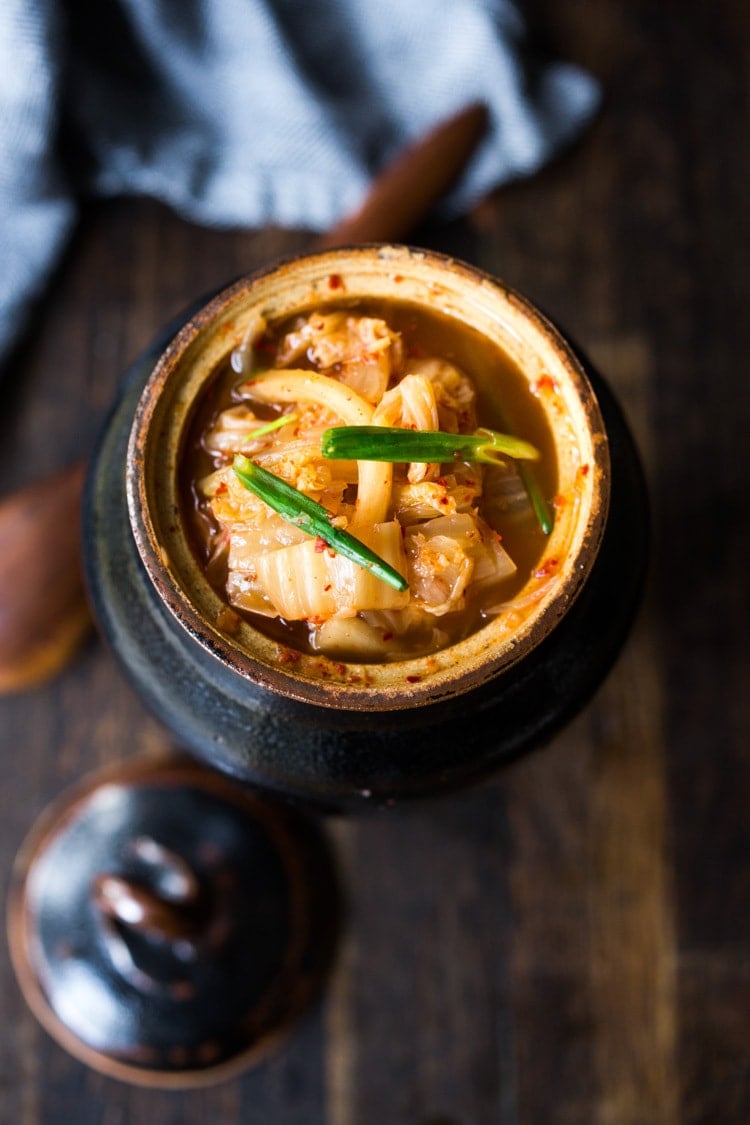
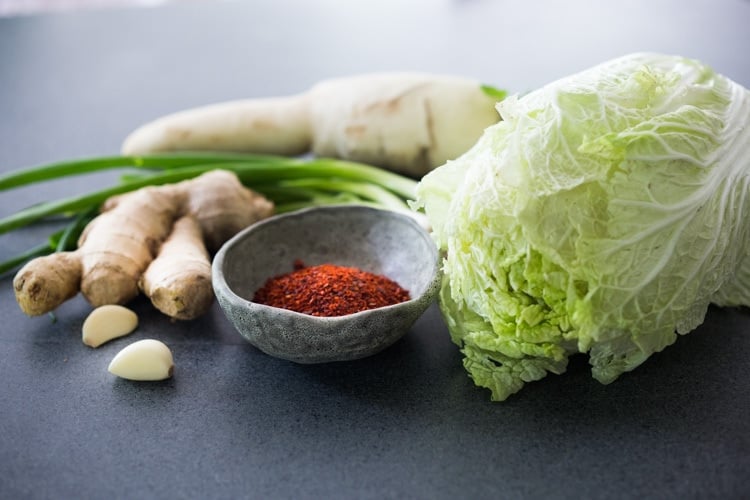
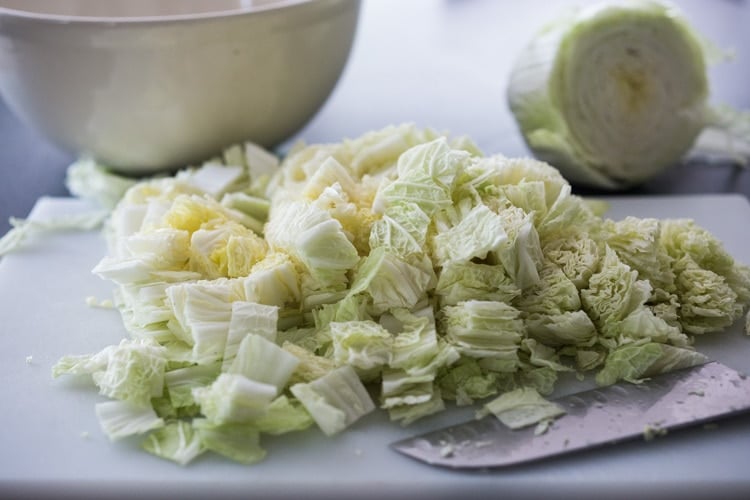
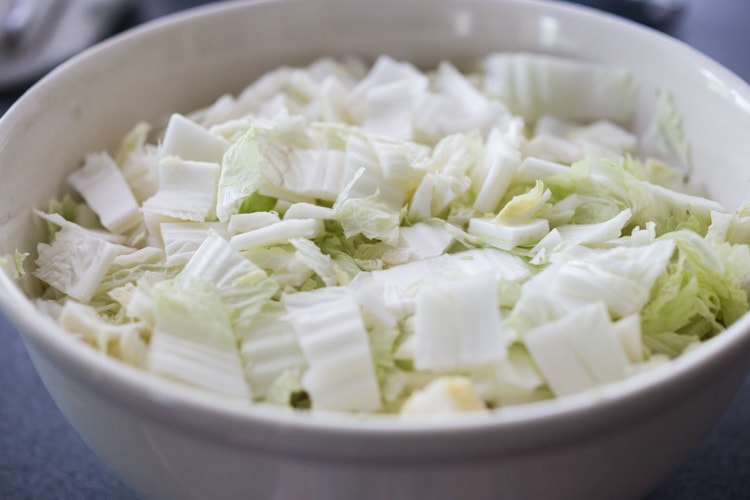
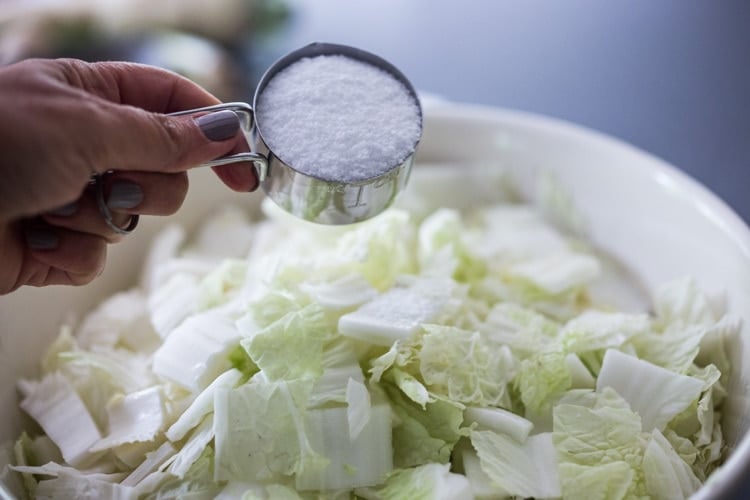
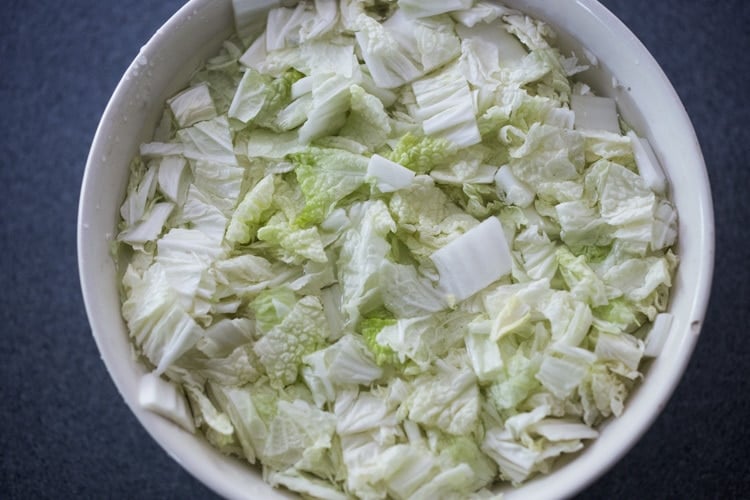
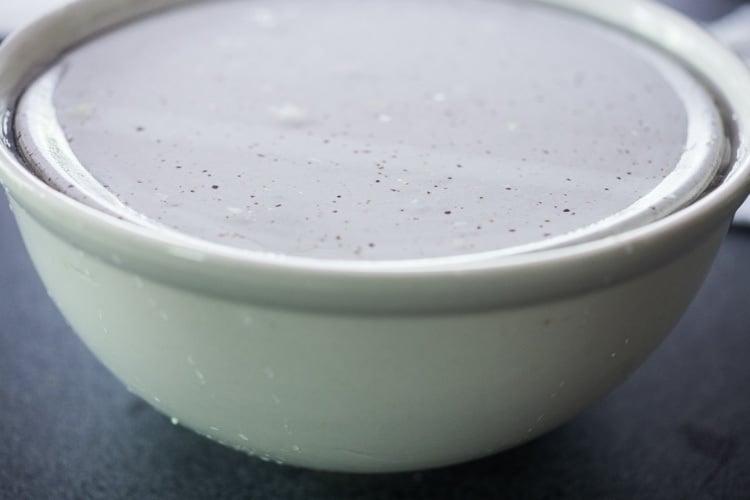
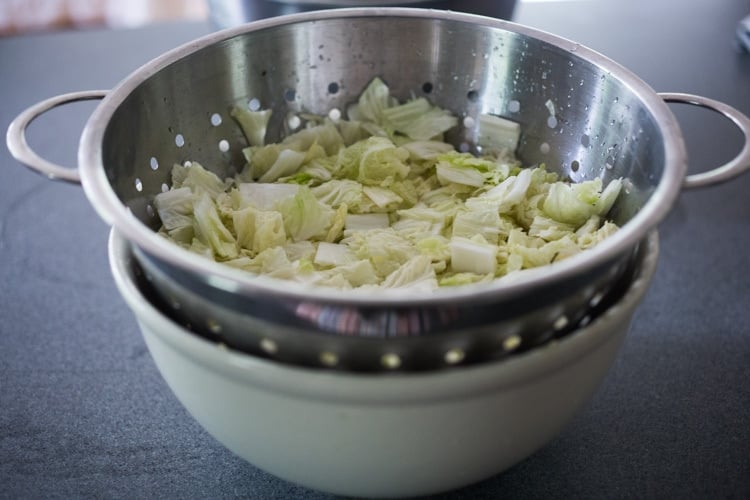
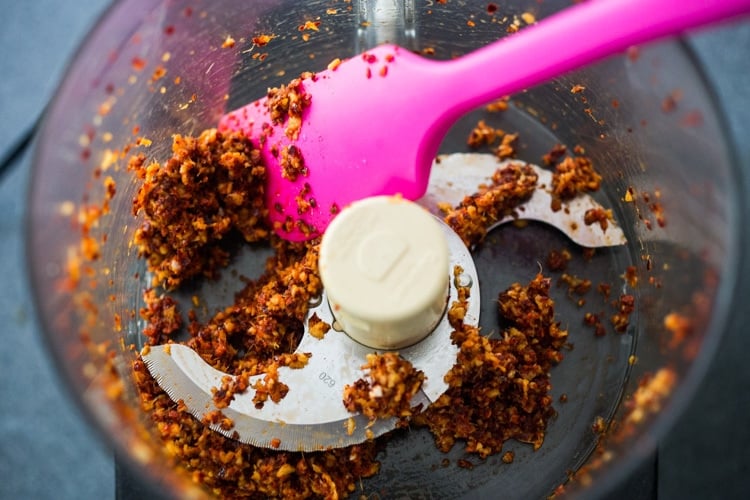
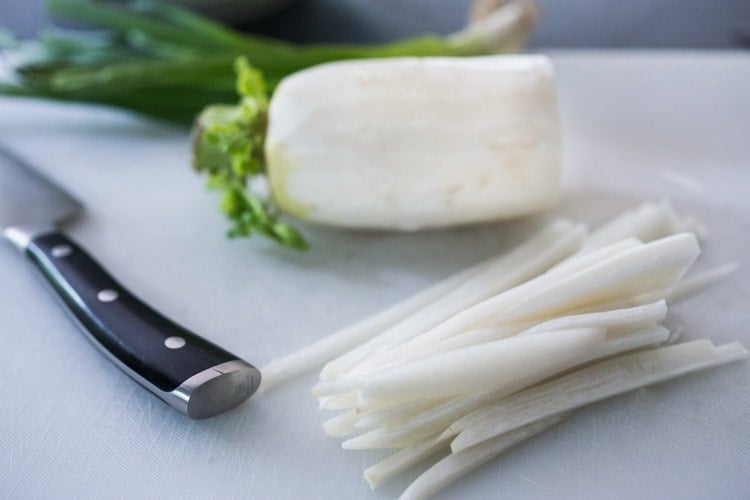
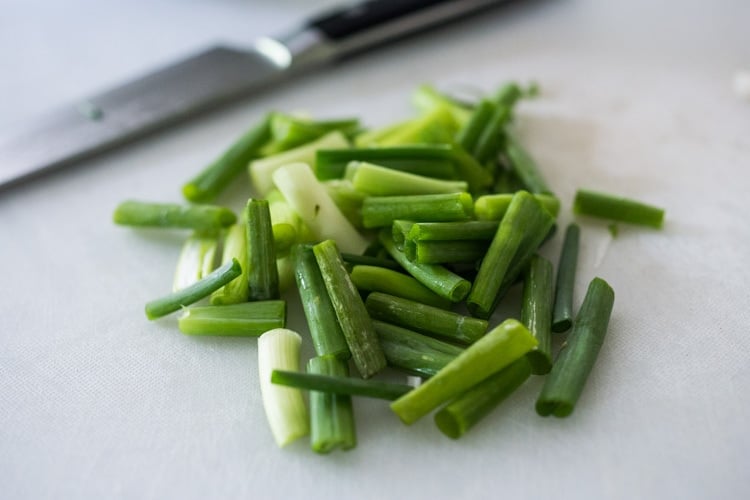
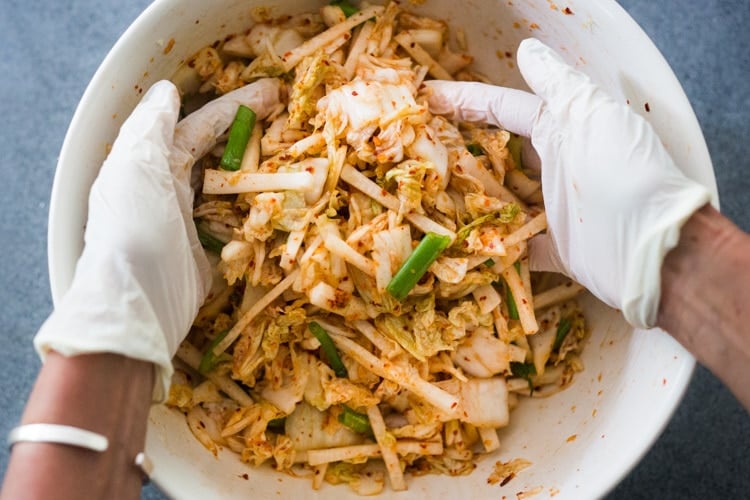
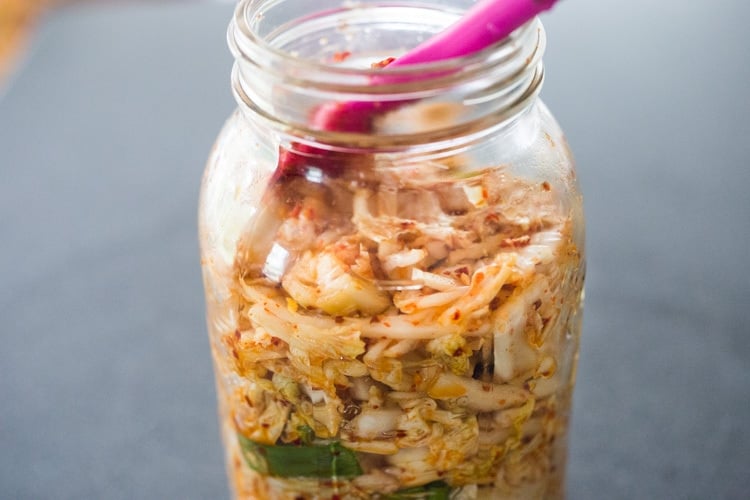
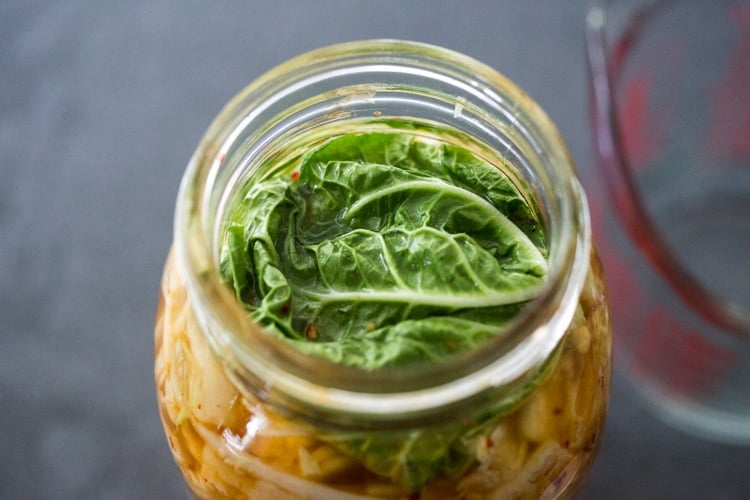
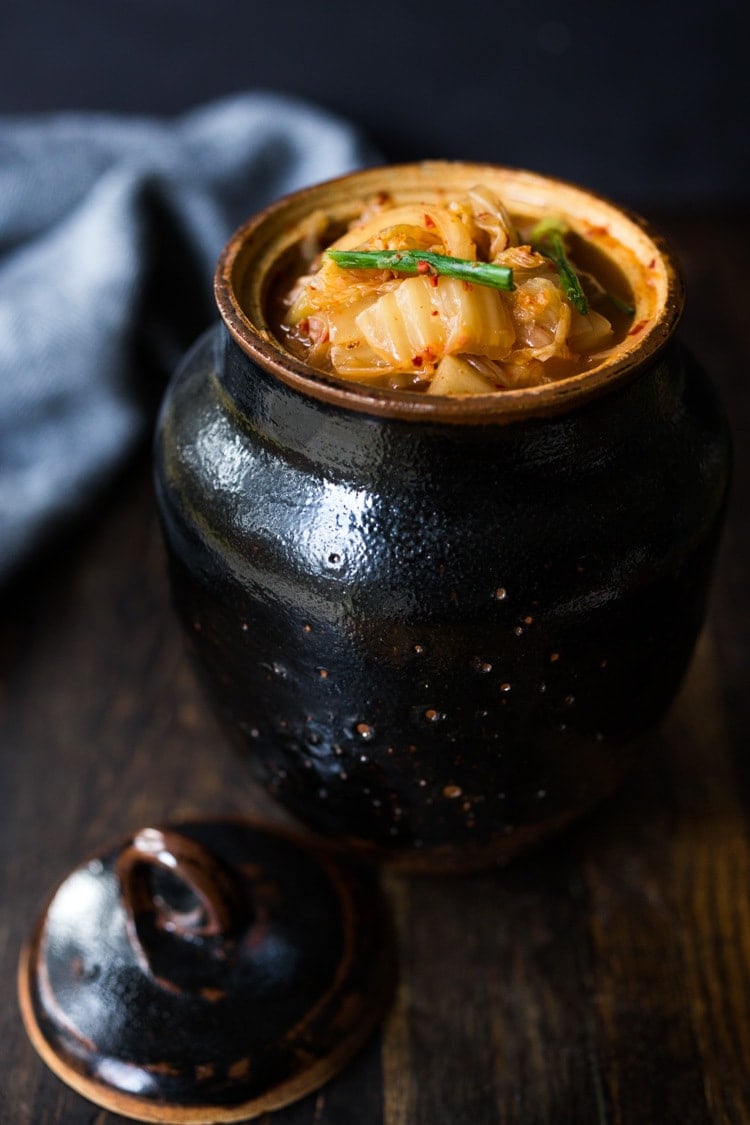
You mentioned temps over 70 could be bad for it, besides in the winter time (which is short lived where I’m at), our house is routinely over 77 (it hovers about 68-70 during the winter). Do you have any suggestions on what I should do?
I think you should be fine…I’d just place in a lower cupboard ( heat rises) somewhere out of direct light.
If you open up the jar while it’s fermenting does it interrupt the fermenting process?
★★★★★
Not at all. 🙂
It was my first attempt at Making Kimchi, the instructions were clear and easy to follow . I enjoy Kimchi when we eat out , I will be enjoying it more often now that I can make it at home
★★★★★
Congrats John! Glad you gave this a go!
Excellent recipe! I have made homemade sauerkraut but was scared to make kimchi. Your recipe was easy to follow and the results are better than storebought. Thank you!
★★★★★
Awesome Aimee! glad you gave it a go!
Thanks for the recipe. I haven’t tried it yet but I plan to soon. FYI, the fermentation kit you linked to does NOT include the jars.
Yes just the weights and lids. I’ll see if I can find one with the jars…
I doubled the recipe and it filled one of the large jars (from the second fermentation kit) with a small bit left over. If someone expects to fill both of those jars, they should make x3 or x4 of this recipe. This was my first time making kimchi, I read many recipes, but followed this one and I am confident that I made great kimchi. The one question that I have is, when my 3 day fermentation was complete, I did find many bubbles or small air pockets. I pressed down on the weight which made nearly all of those bubbles rise. Did I mess anything up by doing this? Should I not have done this? Thanks for the awesome recipe!
★★★★★
You did exactly right Jeremiah! Sounds good!
Just wondering ,is this also a breakfast dish?
I suppose it could be added as a side to savory breakfast things?
I didn’t see the note about the glutinous rice flour…I just added it in with the paste without cooking it. Is it ruined?
I’m not sure! It might still work Eliane- I honestly don’t know. If it is already in there, don’t toss it, just see what happens, and will you let me know? I will update recipe to make it more clear.
It worked fine! The paste was very crumbly because of the lack of water, but as the kimchi fermented, the cabbage produced enough water to make a brine. Very delicious, next time I’ll make sure to cook the glutinous rice flour though!
Great to hear!
Great tasting recipe everyone I give it to loves it third batch stuff is great
★★★★★
Awesome, thanks Jim!
What if I don’t have a food processor?
★★★★★
Just chop /mash everything very finely!
Thank you this was an easy recipe. Did go to the Asian Market & bought Korean chili pepper flakes. Really good. I am a Spice Girl! 2 quarts gone working on the 3rd one. No left😫
★★★★★
Awesome Lynn!